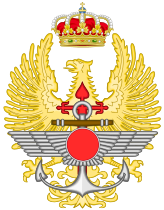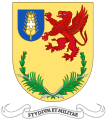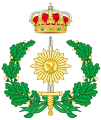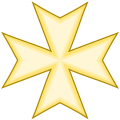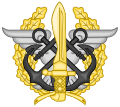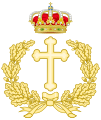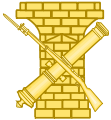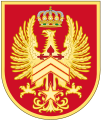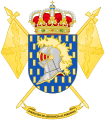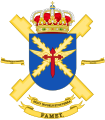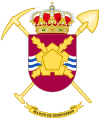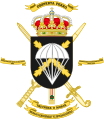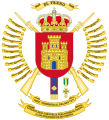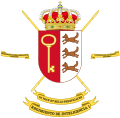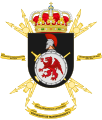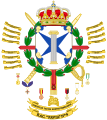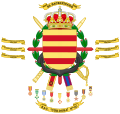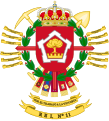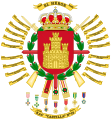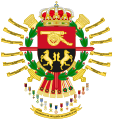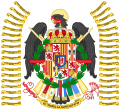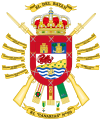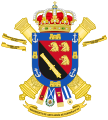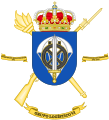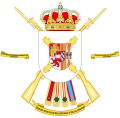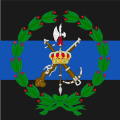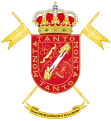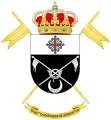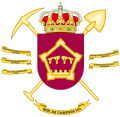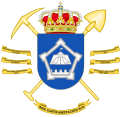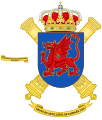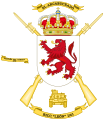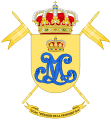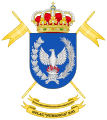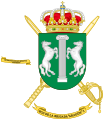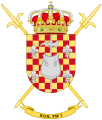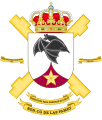Armorial of the Spanish Armed Forces
 From Wikipedia the free encyclopedia
From Wikipedia the free encyclopedia
Spanish military units have coats of arms, badges and emblems to distinguish them from other units both joint Armed Forces and service branches units.
The first evidence of medieval coats of arms is found in the Bayeux Tapestry from the 11th century, where some of the combatants carry shields painted with crosses. Coats of arms came into general use by feudal lords and knights in battle in the 12th century. By the 13th century arms had spread beyond their initial battlefield use to become a kind of flag or logo for families in the higher social classes of Europe. The use of arms spread to Church clergy, and to towns as civic identifiers, and to royally-chartered organizations such as universities and trading companies. In the 21st century, coats of arms are still in use by a variety of institutions and individuals. Military coats of arms and emblems were first required in navies and air forces to recognize naval fleets and squadrons. Nowadays Spanish military insignia are used for official wear or display by military personnel and Armed Forces units and organizations, including branches, commands, cops, brigades, divisions, regiments, battalions, centres et cetera.
Vicente de Cadenas y Vicent (1915–2005), Chronicler King of Arms of Spain, said military objects and natural figures are the most common heraldic charges used in Spanish Armed Forces heraldry. Chimeric figures are also used but they are uncommon. Mister Cadenas y Vicent also noted there are too many wrongly located charges in Spanish military escutcheons.[1][2]
- Emblem of the Spanish Armed Forces (FAS)
- Coat of Arms of the Joint Forces General Staff of the Armed Forces (EMAD)
- Coat of Arms of the Operations Command
(MOPS)
EMAD - Coat of Arms of the Armed Forces Intelligence Center (CIFAS)
EMAD - Emblem of the Joint Cyberspace Command (MCCE)
EMAD - Coat of Arms of the Joint Special Operations Command (MCOE)
EMAD - Coat of Arms of the Health Operating Command (JESANOP)
EMAD - Coat of arms of the Armed Forces Verification Unit (UVE)
EMAD - Coat of Arms of the Armed Forces Communications and Information Systems Command (JCISFAS)
EMAD - Coat of arms of the C-IED National Component (CENCIED)
EMAD
- Coat of Arms of the Defence Medical Inspector General's Office (IGSD)
- Coat of Arms of the Defence Military Pharmacy Center (CEMILFARDEF)
IGSD - Coat of Arms of the Defence Institute of Toxicology (ITOXDEF)
IGSD - Coat of Arms of the Defence Institute of Preventive Medicine (IMPDEF)
IGSD - Coat of Arms of the Military Blood Transfusion Center (CTFAS)
IGSD - Coat of Arms of the Military Veterinary Center (CEMILVET)
IGSD
- Emblem of the Military Construction Service
- Coat of Arms of the Defence Cataloging Service (SERDEF)
- Emblem of the Operations Research Service
- Emblem of the Defence Statistical Service
- Coat of Arms of the Register Office of Armed Forces Professional Associations (RAPFAS)
COPERFAS
- Coat of Arms of the Central Defence Academy
(ACD)
- Coat of Arms of the Medical School (EMISAN)
Central Defence Academy - Emblem of the Military Audit Corps School
(EMI)
Central Defence Academy - Coat of Arms of the Military School of Legal Studies (EMEJ)
Central Defence Academy - Coat of Arms of the Military School of Music (EMUM)
Central Defence Academy - Coat of Arms of the Military School of Education Science (EMCE)
Central Defence Academy - Coat of Arms of the Military School of Languages (EMID)
Central Defence Academy
- Emblem of the National Defence Studies Centre (CESEDEN)
- Emblem of the Armed Forces Higher Staff College (ESFAS)
CESEDEN
- Coat of Arms of the Military Jurisdiction
- Coat of Arms of the Canary Islands Joint Command
(MACOCAN)
Proposed Unit
- Emblem of the Military Medicine
(Common) - Emblem of the Military Medicine
(Ornamented) - Emblem of the Military Legal Corps
- Emblem of the Military Audit Corps
- Emblem of the Military Bands Corps
- Emblem of the Joint Special Operations Command (MCOE)
- Emblem of the Military Archbishopric
- Badge of the Royal and Military Order of Saint Ferdinand
- Badge of the Royal and Military Order of Saint Hermenegild
- Emblem of the former Higher Defence Studies College (EALEDE)
CESEDEN
- Emblem of the former Defence High Command (AEM)
Until 1975 - Emblem of the former Defence High Command (AEM)
1975-1980 - Emblem of the former Board of Joint Chiefs of Staff (JUJEM)
1980-1984
Army[edit]
The Army has a fairly high number of coat of arms used by units, centres and organisms, it is the largest and most consistent military coats of arms collection in Spain. Emblems and badges of Army corps, military occupational specialties and some centres are also relevant. After the Uniformity Report adopted in December 1989, coats of arms design and standardization criteria for Spanish Army units and organizations were adopted according to Army Circular 371/70001/87. The Institute of Military History and Culture (Instituto de Historia y Cultura Militar), an agency of the Army, provides studies of coats of arms and definitive proposals.[3]
Coats of arms used in the Spanish Army have supporters called attributos (attributes) and displayed diagonally, the most important supporters are:
- Units, centres and organisms of Infantry: Two Mauser rifles Spanish model 1893, armed with bayonets.
- Units, centres and organisms of Cavalry: Two Spanish lances model 1861 with flags.
- Units, centres and organisms of Artillery: Two 18th-century Spanish cannons.
- Units, centres and organisms of Military Engineers: One pick and one shovel.
- Units, centres and organisms of Signal Corps: Four Electrodes with rays.
- Units, centres and organisms of Logistics Corps: A Mauser rifle Spanish model 1893 armed with bayonet and one torch.
- Units, centres and organisms of Army Airmobile Force: Two helicopter rotors.
- The Army Headquarters, its divisions, directions, and dependent units directly reporting to it (except the King's Immemorial Infantry Regiment): Two Spanish captain general's batons.
- Staffs at all levels (except the Army Headquarters): Two oak branches.
- The Logistic Support Command and dependent organisms: Two torches.
- The Land Force, Canarias Command, Light Forces, Heavy Forces, General Commands, Military Governments and other units, centres and organizations commanded by a general: One Spanish general's baton and sabre.
- Units, centres and organizations commanded by a superior officer or an officer: One Spanish officer's baton and sabre.
Other relevant heraldic external ornaments are the Spanish Royal Crown and the name of the unit centres and organizations and sometimes the motto is also featured.[4]
- Emblem of the Army (ET)
- Emblem of the Military Staff of the Army (EM)
- Emblem of the Infantry Forces
- Emblem of the Cavalry Forces
- Emblem of the Artillery Forces (Common)
- Emblem of Artillery Forces (Ornamented)
- Emblem of Military Engineers
- Emblem of Logistics Forces
- Emblem of the Spanish Army Logistics Units (Badge)
- Emblem of Specialists Corps
- Emblem of the Army Sea Companies
- Emblem of Polytechnic Engineers
- Emblem and Badge of Military Police
- Emblem of the Legion
- Emblem of Regulares
- Emblem of
Special operations forces - Emblem of Mountain Forces
- Emblem of the Army Airmobile Force (FAMET)
- Emblem of Sergeant Major of the Army
- Coat of Arms of the Army Headquarters
(CGE)
- Coat of Arms of the Army General Staff
(EME)
CGE
- Coat of Arms of the Land Force (FUTER)
- Coat of Arms of Canarias Command (MACAN)
- Coat of Arms of the Operational Logistics Force (FLO)
- Coat of Arms of the High Readiness Land Headquarters (CGTAD)
- Coat of Arms of the NATO Rapid Deployable Corps-Spain Headquarters
(HQ NRDC-SP)
- Coat of Arms of the Economic Affairs Directorate (DIAE)
- Coat of Arms of the CIS Command (JCISAT)
CGE - Coat of Arms of the Logistic Support Command for Operations
(JALOG-OP)
FLO
- Coat of Arms of the Army Inspector General's Office (IGE)
- Coat of Arms of the Army Barracks Directorate (DIACU)
Formerly First Deputy Inspector General's Office - Coat of Arms of the Second Deputy Inspector General's Office "Sur" (SUIGESUR)
- Coat of Arms of the Third Deputy Inspector General's Office "Pirenaica" (SUIGEPIR)
- Coat of Arms of the Fourth Deputy Inspector General's Office "Noroeste" (SUIGENOR)
- Coat of Arms of the Deputy Inspector's Office of the Canarian Forces Command (SUIMCANA)
- Coat of Arms of the Infrastructures Directorate (DINF)
Inspector General's Office
- Coat of Arms of the First Construction Command "Centro"
(COBRA-1)
Infrastructures Directorate - Coat of Arms of the Second Construction Command "Sur"
(COBRA-2)
Infrastructures Directorate - Coat of Arms of the Third Construction Command "Pirenaica"
(COBRA-3)
Infrastructures Directorate - Coat of Arms of the Fourth Construction Command "Noroeste"
(COBRA-4)
Infrastructures Directorate - Coat of Arms of the Fifth Construction Command "Canarias"
(COBRA-5)
Infrastructures Directorate - Coat of Arms of Ceuta Construction Command
(COBRACEU)
Infrastructures Directorate - Coat of Arms of Melilla Construction Command
(COBRAMEL)
Infrastructures Directorate
- Coat of Arms of the Infantry Forces Inspector's Office (IINF)
- Coat of Arms of the Cavalry Forces Inspector's Office (ICAB)
- Coat of Arms of the Artillery Forces Inspector's Office (IART)
- Coat of Arms of the Logistics Forces Inspector's Office (ILOG)
- Coat of Arms of the Logistic Support Command (MALE)
- Coat of Arms of the Acquisitions Directorate (DIAD)
MALE - Coat of Arms of the Integration of Logistics Functions Directorate (DINFULOG)
MALE
- Coat of Arms of the Training and Doctrine Command (MADOC)
- Coat of Arms of the Doctrine, Organization and Equipment Directorate (DIDOM)
MADOC - Coat of Arms of the Education, Training and Evaluation Directorate (DIENADE)
MADOC
- Coat of Arms of the Training Command "Centro"
JEAPRECEN
DIENADE - Coat of Arms of the Training Command "Norte"
JEAPRENOR
DIENADE - Coat of Arms of the Training Command "Sur"
JEAPRESUR
DIENADE - Coat of Arms of the Training Command "Este"
JEAPRESTE
DIENADE - Coat of Arms of the Training Command of the Canary Islands
JEAPRECAN
DIENADE
- Coat of Arms of the Personnel Command (MAPER)
- Coat of Arms of the Personnel Directorate (DIPER)
MAPER - Coat of Arms of the Personnel Support Directorate (DIAPER)
MAPER - Coat of Arms of the Health Directorate (DISAN)
MAPER
- Coat of Arms of División San Marcial
- Coat of Arms of the Division Castillejos
- Coat of Arms of Balearics General Command (COMANGEBAL)
- Coat of Arms of Ceuta General Command (COMENGECEU)
- Coat of Arms of Melilla General Command (COMANGEMEL)
- Coat of Arms of the Army Air Defence Command (MAAA)
- Coat of Arms of the Army Field Artillery Command (MACA)
- Coat of Arms of the Special Operations Force Command (MOE)
- Coat of Arms of the Army Airmobile Force (FAMET)
- Coat of Arms of the Engineer Command (MING)
- Coat of Arms of the Signals Command (MATRANS)
- Coat of Arms of the Logistic Brigade (BRILOG)
- Coat of Arms of the Medical Brigade (BRISAN)
- Coat of Arms of 1st "Aragón" (BOP I)
- Coat of Arms of 2nd Legion Brigade "King Alfonso XIII"
(BOP LEG II) - Coat of Arms of 6th Paratrooper Brigade "Almogávares"
(BOP PAC VI) - Coat of Arms of 7th Brigade "Galicia"
(BOP VII) - Coat of Arms of 10th Brigade "Guzmán el Bueno" (BOP X)
- Coat of Arms of 11th Brigade "Extremadura"
(BOP XI) - Coat of Arms of 12th "Guadarrama"
(BOP XII) - Coat of Arms of 16th Brigade "Canarias"
(BOP XVI)
- Coat of Arms of the 1st King's Immemorial Infantry Regiment of AHQ (RI-1)
- Coat of Arms of the 1st Intelligence Regiment (RINT-1)
- Coat of Arms of the 1st Information Operations Regiment (ROI-1)
- Coat of Arms of the 1st CBRN-Defense Regiment "Valencia" (RDNBQ)
- Coat of Arms of the 1st Engineer Regiment
(RINT-1) - Coat of Arms of the 1st Signal Regiment (RT-1)
- Coat of Arms of the 2nd Infantry Regiment "La Reina" (RI-2)
- Coat of Arms of the 3rd Infantry Regiment "Príncipe" (RI-3)
- Coat of Arms of the 3rd Cavalry Regiment "Montesa" (RC-3)
- Coat of Arms of the 4th Armoured Regiment "Pavía" (RAC-4)
- Coat of Arms of the 4th Coastal Artillery Regiment (RACTA-4)
- Coat of Arms of the 6th Infantry Regiment "Saboya"
(RI-6)
Standardized - Coat of Arms of the 6th Infantry Regiment "Saboya"
(RI-6)
Common - Coat of Arms of the 7th Engineer Regiment (RING-7)
- Coat of Arms of the 8th Engineer Regiment (RING-8)
- Coat of Arms of the 9th Infantry Regiment "Soria" (RI-9)
- Coat of Arms of the 10th Armored Cavalry Regiment "Alcántara" (RCAC-10)
- Coat of Arms of the 10th Armored Regiment "Córdoba"
(RAC-10)
Standardized - Coat of Arms of the 10th Armored Regiment "Córdoba"
(RAC-10)
Common - Coat of Arms of the 11th Cavalry Regiment "España" (RC-11)
- Coat of Arms of the 11th Field Artillery Regiment (RACA-11)
- Coat of Arms of the 11th Engineers' Specialities (REI-11)
- Coat of Arms of the 12th Cavalry Regiment "Farnesio" (RC-12)
- Traditional and common emblem of the 12th Cavalry Regiment "Farnesio"
(RC-12) - Coat of Arms of the 12th Bridge Engineer Regiment (RPEI-12)
- Coat of Arms of the 16th Armored Regiment "Castilla"
(RAC-16)
Standardized - Coat of arms of the 16th Armored Regiment "Castilla"
(RAC-16)
Common - Coat of Arms of the 20th Field Artillery Regiment (RACA-20)
- Coat of Arms of the 21st Signal Regiment (RT-21)
- Coat of Arms of the 22nd Signal Regiment (RT-22)
- Coat of Arms of the 29th Infantry Regiment "Isabel la Católica"
(RI-29)
Ornamented - Coat of Arms of the 29th Infantry Regiment "Isabel la Católica"
(RI-29)
Common - Coat of Arms of the 30th Mixed Artillery Regiment (RAMIX-30)
- Coat of Arms of the 31st Mechanized Infantry Regiment "Asturias" (RIMZ-31)
Standardized - Coat of Arms of the 31st Mechanized Infantry Regiment "Asturias" (RIMZ-31)
Common - Coat of Arms of the 31st Electronic Warfare Regiment (REW-31)
- Coat of Arms of the 32nd Mixed Artillery Regiment (RAMIX-32)
- Coat of Arms of the 32nd Electronic Warfare Regiment (REW-32)
- Coat of Arms of the 45th Infantry Regiment "Garellano", (RI-45)
- Coat of Arms of the 47th Infantry Regiment "Palma"
(RI-47) - Coat of Arms of the 49th Infantry Regiment "Tenerife"
(RI-49) - Coat of Arms of the 50th Infantry Regiment "Canarias"
(RI-50)
Standardized - Coat of Arms of the 50th Infantry Regiment "Canarias"
(RI-50)
Common - Coat of Arms of the 61st Armoured Infantry Regiment "Alcázar de Toledo" (RIAC-61)
- Coat of Arms of the 62nd Infantry Regiment "Arapiles" (RI-62)
- Coat of Arms of the 63rd Infantry Regiment "Barcelona" (RI-63)
- Coat of Arms of the 63rd Rocket Artillery Regiment (RALCA-63)
- Coat of Arms of the 64th Mountain Hunters Regiment "Galicia" (RCZM-64)
- Coat of Arms of the 66th Infantry Regiment "América" (RI-66)
- Coat of Arms of the 67th Infantry Regiment "Tercio Viejo de Sicilia" (RI-67)
- Coat of Arms of the 71st Air Defence Artillery Regiment (RAAA-71)
- Coat of Arms of the 73rd Air Defence Artillery Regiment (RAAA-73)
- Coat of Arms of the 74th Air Defence Artillery Regiment (RAAA-74)
- Coat of Arms of the 93rd Field Artillery Regiment (RACA-93)
- Coat of Arms of the 94th Air Defence Artillery Regiment (RAAA-94)
- Coat of Arms of the Parachute Brigade Headquarters
(CG BRIPAC-VI)
- Coat of arms of the 4th Parachute Infantry Regiment "Napoles" (RIPAC-4)
- Coat of arms of the 5th Infantry Regiment "Zaragoza" (RI-5)
- Coat of Arms of the 8th Cavalry Regiment Lusitania (RC-8)
- Coat of arms of the 1st-4 Parachute Infantry Flag "Roger de Flor" (BIPAC-I/4)
- Coat of Arms of the 2nd-4 Protected Infantry Flag "Roger de Lauria" (BIP-II/4)
- Coat of Arms of the 3rd-5 Protected Infantry Flag "Ortiz de Zárate" (BIP-III/5)
- Coat of Arms of the 6th Field Parachute Artillery Battalion (GACAPAC-VI)
- Coat of Arms of the 6th Engineer Battalion (BZAP-VI)
- Coat of Arms of the 6th Logistic Battalion (GL-VI)
- Coat of Arms of the 6th Parachute Signal Company (CIATRANSPAC-6)
- Coat of Arms of the Parachute Brigade Headquarters Battalion (BON CG BRIPAC)
- Coat of Arms of the Air Drop Unit (ULANPAC)
- Coat of Arms of the Parachute Anti-Tank Defense Company (CIADCCPAC)
- Coat of Arms of the Parachute Brigade Intelligence Company (CIAINTPAC)
- Coat of Arms of the 1st-8 Light Armored Cavalry Group "Sagunto" (GCLAC-I/8)
- Coat of Arms of the Base Services Unit "Príncipe" (USBA)
- Coat of Arms of the Barracks Services Unit "Primo de Rivera" (USAC)
- Coat of Arms of the Barracks Services Unit "Santa Bárbara" (USAC)
- Coat of Arms of the Parachute Instruction Unit (UFPAC)
- Coat of Arms of the 1st Spanish Legion Tercio "Great Captain"
- Emblem of the 1st Spanish Legion Tercio "Great Captain"
- Coat of Arms of the 2nd Spanish Legion Tercio "Duke of Alba"
- Emblem of the 2nd Spanish Legion Tercio "Duke of Alba"
- Coat of Arms of the 3rd Spanish Legion Tercio "Don Juan de Austria"
- Emblem of the 3rd Spanish Legion Tercio "Don Juan de Austria"
- Coat of Arms of the 4th Spanish Legion Tercio "Alexander Farnese"
- Emblem of 4th Spanish Legion Tercio "Alexander Farnese"
- Coat of Arms of the 1st-1 Protected Infantry Flag "Commander Franco"
(BIP-I/1) - Coat of Arms of the 4th-2 Protected Infantry Flag "Christ of Lepanto"
(BIP-IV/2) - Coat of Arms of the 7th-3 Protected Infantry Flag "Lieutenant Colonel Valenzuela"
(BIP-VII/3) - Coat of Arms of the 8th-3 Protected Infantry Flag "Christopher Columbus"
(BIP-VIII/3) - Coat of Arms of the 10th-4 Motorized Infantry Flag "Millán Astray"
(BIP-VIII/4) - Coat of Arms of the 2nd Light Armored Cavalry Group of the Legion "Catholic Monarchs"
(GCLACLEG-II)
- Coat of Arms of the 2nd Headquarters Flag of the Legion Brigade
(BCG BRILEG-II) - Coat of Arms of the 2nd Field Artillery Battalion of the Legion
(GACALEG-II) - Coat of Arms of the 2nd Military Engineering Battalion (or Flag) of the Legion
(BZAPLEG-II) - Coat of Arms of the 2nd Logistics Group of the Legion
(GLLEG-II) - Coat of Arms of the 2nd Signals Company of the Legion
(CIATRANSLEG-II) - Coat of Arms of the Anti-Tank Defense Company of the Legion
(CIA-DCC-LEG) - Coat of Arms of the Intelligence Company of the Legion
(CIA-INT-LEG) - Coat of Arms of the Band of the Legion
- Coat of Arms of the Base Services Unit "Álvarez de Sotomayor"
(USBA)
- Coat of Arms of the 52nd Regulares Light Infantry Group/Regiment
(GR-52) - Coat of Arms of the 54th Regulares Light Infantry Group/Regiment
(GR-54)
- Coat of Arms of the 1st-52 Regulares Battalion "Alhucemas"
(TR-I/52) - Coat of Arms of the 1st-54 Regulares Battalion "Tetuán"
(TR-I/54)
- Coat of Arms of the Special Operations Command Headquarters Group
(GCG-MOE) - Coat of Arms of the 2nd Special Operations Group "Granada"
(GOE-II) - Coat of Arms of the 3rd Special Operations Group "Valencia"
(GOE-III) - Coat of Arms of the 4th Special Operations Group "Tercio del Ampurdán"
(GOE-IV) - Coat of Arms of the 19th Special Operations Group "Maderal Oleaga"
(GOE-XIX) - Coat of Arms of the Special Operations Command Signals Company
(CIA TRANS MOE) - Coat of Arms of the Barracks Services Unit "Alférez Rojas Navarrete"
(USAC)
- Coat of Arms of the High Readiness Land Headquarters Battalion (BON CG CGTAD)
- Coat of Arms of the Infantry Battalion "Guardia Vieja de Castilla" (BI)
- Coat of Arms of the 1st-1 NBC-Defense Battalion (BNBQ I/1)
- Coat of Arms of the 1st-1Combat Engineer Battalion
(BZAP-I/1) - Coat of Arms of the 1st-2 Protected Infantry Battalion "Princesa" (BIP-I/2)
- Coat of Arms of the 1st-3 Protected Infantry Battalion "San Quintín" (BIP-I/3)
- Coat of Arms of the 1st-4 Tank Infantry Battalion "Flandes" (BICC-I/4)
- Coat of Arms of the 1st-3 Armored Cavalry Group "Cazadores de África" (GCAC-I/3)
- Coat of Arms of the 1st-4 Coastal Artillery Battalion (GACTA-I/4)
- Coat of Arms of the 1st-6 Mechanized Infantry Battalion "Cantabria" (BIMZ-I/6)
- Coat of Arms of the 1st-7 Combat Engineer Battalion I/7
(BZAP-I/7) - Coat of Arms of the 1st-8 Combat Engineer Battalion
(BZAP-I/8) - Coat of Arms of the 1st-9 Protected Infantry Battalion "Fuerteventura" (BIPROT-I/9)
- Coat of Arms of the 1st-10 Armored Cavalry Group "Taxdirt" (GCAC-I/10)
- Coat of Arms of the 1st-10 Tank Infantry Battalion "Málaga"
(BICC-I/10) - Coat of Arms of the 1st-11 Light Armored Cavalry Group "Lanceros de Borbón" (GCLAC-I/11)
- Coat of Arms of the 1st-11 Field Artillery Battalion (GACA-I/11)
- Coat of Arms of the 2nd-11 Field Artillery Battalion (GACA-II/11)
- Coat of Arms of the 1st-11 Road Building Battalion
(BCAM-I/11) - Coat of Arms of the 2nd 11 Camp Building Battalion
(BCAS-II/11) - Coat of arms of the 1st-12 Light Armored Cavalry Group "Santiago"
(GCLAC-I/12) - Coat of Arms of the 1st-12 Bridge Building Battalion
(BPON-I/12) - Coat of Arms of the 2nd-12 Railroad Building Battalion
(BEI-II/12) - Coat of Arms of the 1st-16 Tank Infantry Battalion "Mérida"
(BICC-I/16) - Coat of Arms of the 1st-20 Field Artillery Battalion (GACA-I/20)
- Coat of Arms of the 1st-29 Protected Infantry Battalion "Zamora" (BIP-I/29)
- Coat of Arms of the 1st-30 Field Artillery Battalion (GACA-I/30)
- Coat of Arms of the 1st-31 Mechanized Infantry Battalion "Covadonga" (BIMZ-I/31)
- Coat of Arms of the 1st-32 Field Artillery Battalion (GACA-I/32)
- Coat of Arms of the 1st-45 Motorized Infantry Battalion "Guipúzcoa" (BIMT-I/45)
- Coat of Arms of the 1st-47 Motorized Infantry Battalion "Filipinas" (BIMT-I/45)
- Coat of Arms of the 1st-49 Motorized Infantry Battalion "Albuera"
(BIMT-I/49) - Coat of Arms of the 1st-50 Protected Infantry Battalion "Ceriñola"
(BIPROT-I/50) - Coat of Arms of the 1st-61 Tank Infantry Battalion "León"
(BICC-I/61) - Coat of Arms of the 1st-62 Mechanized Infantry Battalion "Badajoz" (BIMZ-I/62)
- Coat of Arms of the 1st-63 Motorized Infantry Battalion "Cataluña"
(BIMT-I/63) - Coat of Arms of the 1st-63 Rocket Artillery Group (GALCA-I/63)
- Coat of Arms of the 1st-64 Mountain Hunters Battalion "Pirineos" (BCZM-I/64)
- Coat of Arms of the 1st-64 Skiing-Climbing Company
(CEE-1/64) - Coat of Arms of the 1st-66 Motorized Infantry Battalion "Montejurra" (BIMT-I/66)
- Coat of Arms of the 1st-67 Motorized Infantry Battalion "Legazpi" (BIMT-I/67)
- Coat of Arms of the 1st-71 Air Defence Artillery Battalion (GAAA-I/71)
- Coat of Arms of the 1st-73 Aspide Air Defence Artillery Battalion
(GAAA-ASPIDE-I/73) - Coat of Arms of the 1st-74 Air Defence Artillery Battalion
(GAAA I/74) - Coat of Arms of the 1st-93 Field Artillery Battalion (GACA-I/93)
- Coat of Arms of the 1st-94 Air Defence Artillery Battalion (GAAA-I/94)
- Coat of Arms of the 1st Engineer Battalion
(BZAP I) - Coat of Arms of the 1st Signals Company
(CIATRANS-1) - Coat of Arms of the 2nd-2 Mechanized Infantry Battalion "Lepanto" (BIMZ-II/2)
- Coat of Arms of the 2nd-3 Protected Infantry Battalion "Toledo" (BIP-II/3)
- Coat of Arms of the 2nd-4 Cavalry Armored Group "Húsares de la Princesa"
(GCAC-II/4) - Coat of Arms of the 2nd-6 Protected Infantry Battalion "Las Navas" (BIP-II/6)
- Coat of Arms of the 2nd-32nd Air Defence Artillery Battalion (GAAA-II/32)
- Coat of Arms of the 2nd-10 Armored Cavalry Group "Almansa"
(GCAC-II/10) - Coat of Arms of the 2nd-11 Light Armored Cavalry Group "Numancia"
(GLCAC-II/11) - Coat of Arms of the 2nd-16 Armored Cavalry Group "Calatrava"
(GCAC-II/16) - Coat of Arms of the 2nd–30th Air Defence Artillery Battalion (GAAA-II/30)
- Coat of Arms of the 2nd-31 Protected Infantry Battalion "Uad Ras" (BIP-II/31)
- Coat of Arms of the 2nd-71 Air Defence Artillery Battalion (GAAA-II/71)
- Coat of Arms of the 2nd-73 NASAMS Air Defence Artillery Battalion
(GAAA-NASAMS-II/73) - Coat of Arms of the 2nd-74 Air Defence Artillery Battalion (GAAAM-II/74)
- Coat of Arms of the Coat of Arms of the 2nd-63 Information and Location Artillery Battalion
(GAIL-II/63) - Coat of Arms of the 3rd-73 Patriot Air Defence Artillery Battalion
(GAAA-PATRIOT-III/73) - Coat of Arms of the 3rd-74 Repair Unit (UR-III/74)
- Coat of Arms of the 7th Field Artillery Battalion
(GACA-VII) - Coat of Arms of the 7th Engineer Battalion
(BZAP-VII) - Coat of Arms of the 7th Signals Company
(CIATRANS-7) - Coat of Arms of the 10th Field Artillery Battalion
(GACA-X) - Coat of Arms of the 10th Engineer Battalion
(BZAP-X) - Coat of Arms of the 10th Signals Company
(CIATRANS-10) - Coat of Arms of the 11th Field Artillery Battalion
(GACA-XI) - Coat of Arms of the 11th Engineer Battalion
(BZAP-XI) - Coat of Arms of the 11th Signals Company
(CIATRANS-11) - Coat of Arms of the 12th Armored Cavalry Group "Villaviciosa"
(GCAC-XII) - Coat of arms of the 12th Self Propelled Field Artillery Battalion
(GACA ATP XII) - Coat of Arms of the 12th Engineer Battalion
(BZAP-XII) - Coat of Arms of the 12th Signals Company
(CIATRANS-12) - Coat of Arms of the 16th Light Armored Cavalry Group "Milán" XVI (GCLAC-XVI)
- Coat of Arms of the 16th Engineer Battalion
(BZAP-XVI) - Coat of Arms of the 16th Signals Company
(CIATRANS-16) - Coat of Arms of the 17th Signals Company
(CIATRANS-17) - Coat of Arms of the 18th Signals Company
(CIATRANS-18) - Coat of Arms of the Division "Castillejos" Headquarters
- Coat of Arms of the Division "Castillejos" Headquarters Battalion
- Coat of Arms of the Division "San Marcial" Headquarters
- Coat of Arms of the Division "San Marcial" Headquarters Battalion
- Coat of Arms of the Signal Battalion of the Air Defence Command (UTMAAA)
- Coat of Arms of the 1st Brigade "Aragón" Headquarters Battalion
(BCG BR I) - Coat of Arms of the 7th Brigade "Galicia" Headquarters Battalion
(BCG BR VII) - Coat of Arms of the 10th Brigade "Guzmán el Bueno" Headquarters Battalion
(BCG BR X) - Coat of Arms of the 11th Brigade "Extremadura" Headquarters Battalion
(BCG BR XI) - Coat of Arms of the 12th Brigade "Guadarrama" Headquarters Battalion
(BCG BR XII) - Coat of Arms of the 16th Brigade "Canarias" Headquarters Battalion
(BCG BR XVI) - Coat of Arms of the Ceuta General Command Headquarters Battalion
(BCG-COMGECEU) - Coat of Arms of the Melilla General Command Headquarters Battalion
(BCG-COMGEMEL) - Coat of Arms of the Music Unit of the RI-1
- Coat of Arms of the Support Unit of the RI-1
- Coat of Arms of the Personnel Command of the Canary Islands (JEPERCANA)
- Coat of Arms of the Personnel Command of Ceuta (JEPERCE)
- Coat of Arms of the Personnel Command of Melilla (JEPERMEL)
- Coat of Arms of the 1st-1 Intelligence Analysis Group
(GRINT-I/1)
RINT-1 - Coat of Arms of the 2nd-1 Long Range Reconnaissance Group
(GROBT-II/1)
RINT-1 - Coat of Arms of the 4th-1 Unmanned Aerial Vehicles Group
(GROSA IV/1)
RINT-1 - Coat of Arms of the 1st Civil-Military Cooperation Battalion (BCIMIC-I/1)
ROI-1 - Coat of Arms of the 2nd-1 Information Operations Group
(GROPS-II/1)
ROI-1
- Coat of Arms of the 1st Military Police Battalion (BON PM-I)
- Coat of Arms of the Army Airmobile Force Headquarters (CG-FAMET)
- Coat of Arms of the 1st Attack Helicopter Battalion (BHELA-I)
- Coat of Arms of the 2nd Emergency Helicopter Battalion (BHELEME-II)
- Coat of Arms of the 3rd Maneuver Helicopter Battalion (BHELMA-III)
- Coat of Arms of the 4th Maneuver Helicopter Battalion (BHELMA-IV)
- Coat of Arms of the 5th Transport Helicopter Battalion (BHELTRA-V)
- Coat of Arms of the 6th Maneuver Helicopter Battalion (BHELMA-VI)
- Coat of Arms of the Army Airmobile Force Headquarters and Signals Battalion
(BCG-FAMET) - Coat of Arms of the Army Airmobile Force Logistics Group
(GL-FAMET) - Coat of Arms of the Army Helicopters Maintenance Park and Center (PCMHEL)
- Coat of Arms of the Base Services Unit "Coronel Maté" (USBA)
- Coat of Arms of the Army Helicopters Training Center (CEFAMET)
- Coat of Arms of the Transport Grouping (ATP)
- Coat of Arms of the 11th Logistics Support Grouping
(AALOG-11) - Coat of Arms of the 21st Logistics Support Grouping (AALOG-21)
- Coat of Arms of the 41st Logistics Support Grouping (AALOG-41)
- Coat of Arms of the 61st Logistics Support Grouping (AALOG-61)
- Coat of Arms of the 81st Logistics Support Grouping (AALOG-81)
- Coat of Arms of the 1st Logistics Group
(GLOG-I) - Coat of Arms of the 7th Logistics Air-transportable Group (GLAT-VII)
- Coat of Arms of the 10th Logistics Group
(GLOG-X) - Coat of Arms of the 11th Logistics Group
(GLOG-XI) - Coat of Arms of the 12th Logistics Group
(GLOG-XII) - Coat of Arms of the 16th Logistics Group
(GLOG-XVI) - Coat of Arms of the 23rd Logistics Unit (ULOG-23)
- Coat of Arms of the 24th Logistics Unit (ULOG-24)
- Coat of Arms of the 1st-11 Supply Group
(GRABTO-I/11) - Coat of Arms of the 3rd-11 Projection Support Group
(GAPRO-III/11) - Coat of Arms of the 6th-11 Maintenance Group
(GRUMA-VI/11) - Coat of Arms of the 112th Services and Mechanical Workshops Unit
(UST-112) - Coat of Arms of the 1st-21 Supply Group
(GRABTO-I/21) - Coat of Arms of the 6th-21 Maintenance Group
(GRUMA-VI/21) - Coat of Arms of the 9th-21 Transport Group
(GTRANSP-IX/21) - Coat of Arms of the 212th Services and Mechanical Workshops Unit
(UST-212) - Coat of Arms of the 1st-41 Supply Group
(GRABTO-I/41) - Coat of Arms of the 6th-41 Maintenance Group
(GRUMA-VI/41) - Coat of Arms of the 9th-41 Transport Group
(GTRANSP-IX/41) - Coat of Arms of the 412th Services and Mechanical Workshops Unit
(UST-412) - Coat of Arms of the 1st-61 Supply Group
(GRABTO-I/61) - Coat of Arms of the 3rd-61 Logistics Group (GLOG-III/61)
- Coat of Arms of the 612th Services and Mechanical Workshops Unit
(UST-612) - Coat of Arms of the 6th-81 Maintenance Group
(GRUMA-VI/81) - Coat of Arms of the 811th Munitions Battery
(BATMUN-811) - Coat of Arms of the 812th Services and Mechanical Workshops Unit
(UST-812) - Coat of Arms of the Automobile Unit of the RI-1
- Coat of Arms of the Ceuta Sea Company
- Coat of Arms of the Melilla Sea Company
- Coat of Arms of the Projection Support Unit "Marques de Herrera" (UAPRO)
- Coat of Arms of the Projection Support Unit "El Fuerte" (UAPRO)
- Coat of Arms of the Projection Support Unit "Anatolio Fuentes" (UAPRO)
- Coat of Arms of the Projection Support Unit "Christopher Columbus" (UAPRO)
- Coat of Arms of the Projection Support Unit "San Isidro" (UAPRO)
- Coat of Arms of the Logistics Centers Command
(JECELOG)
DINFULOG
- Coat of Arms of the Logistics Material Supplying Park and Center (PCAMI)
- Coat of Arms of the Signal Equipment Maintenance Park and Center (PCMMT)
- Coat of Arms of the Military Engineers Equipment Maintenance Park and Center (PCMMI)
- Coat of Arms of the 1st Wheeled Vehicles Maintenance Park and Center (PCMVR-1)
- Coat of Arms of the 2nd Wheeled Vehicles Maintenance Park and Center (PCMVR-2)
- Coat of Arms of the 1st Armored Systems Maintenance Park and Center (PCMASA-1)
- Coat of Arms of the 2nd Armored Systems Maintenance Park and Center (PCMASA-2)
- Coat of Arms of the Artillery Weaponry and Equipment Maintenance Park and Center (PCMAYMA)
- Coat of Arms of the Air Defence, Coastal and Missile Systems Maintenance Park and Center (PCMASACOM)
- Coat of Arms of the Hardware and Software Systems Maintenance Park and Center (PCMSHS)
- Coat of Arms of the Army's Central Laboratory (LCE)
- Coat of Arms of the Discontinuous Services Unit "Cavalcanti"
(USBAD) - Coat of Arms of the Discontinuous Services Unit "Ceuta"
(USBAD) - Coat of Arms of the Discontinuous Services Unit "Melilla"
(USBAD) - Coat of Arms of the Discontinuous Services Unit "Teniente Flomesta"
(USBAD) - Coat of Arms of the Discontinuous Services Unit "Oroel"
(USBAD) - Coat of Arms of the Discontinuous Services Unit "San Jorge"
(USBAD) - Coat of Arms of the Discontinuous Services Unit "La Cuesta"
(USBAD)
- Coat of Arms of the Base Services Unit
"El Goloso"
(USBA) - Coat of Arms of the Base Services Unit
"Cerro Muriano"
USBA) - Coat of Arms of the Base Services Unit
"General Menacho"
USBA) - Coat of Arms of the Base Services Unit
"El Copero"
(USBA) - Coat of Arms of the Base Services Unit "Jaime I"
(USBA) - Coat of Arms of the Base Services Unit
"General Almirante"
(USBA) - Coat of Arms of the Base Services Unit "Araca"
(USBA) - Coat of Arms of the Base Services Unit
"Cid Campeador"
(USBA) - Coat of Arms of the Base Services Unit
"Conde de Gazola"
(USBA) - Coat of Arms of the Base Services Unit
"General Morillo"
(USBA) - Coat of Arms of the Base Services Unit
"El Empecinado"
(USBA) - Coat of Arms of the Base Services Unit "General Alemán Ramírez"
(USBA) - Coat of Arms of the Barracks Services Unit "General Álvarez de Castro"
(USAC) - Coat of Arms of the Barracks Services Unit "Cabo Noval"
(USAC) - Coat of Arms of the Barracks Services Unit "Loyola"
(USAC) - Coat of Arms of the Barracks Services Unit "Aizoáin"
(USAC)
- Coat of Arms of the 1st Health Services Group (AGRUSAN-1)
- Coat of Arms of the 3rd Health Services Group (AGRUSAN-3)
- Coat of Arms of the Health Logistics Support Unit (UALSAN)
- Coat of Arms of the 1st-1 Health Services Group
(UAPOSAN-I/1)
AGRUSAN-1 - Coat of Arms of the 2nd-1 Health Services Group
(UAPOSAN-II/1)
AGRUSAN-1 - Coat of Arms of the 3rd-3 Health Services Group
(GRUSAN-III/3)
AGRUSAN-3 - Coat of Arms of the 4th-3 Health Services Group
(GRUSAN-IV/3)
AGRUSAN-3 - Coat of Arms of the NBC Decontamination Sanitary Station (EDSBNQ)
AGRUSAN-3
- Coat of Arms of the General Military Academy (AGM)
- Coat of Arms of the Infantry Academy (ACINF)
Ornamented - Coat of Arms of the Infantry Academy (ACINF)
Common - Coat of Arms of the Cavalry Academy (ACAB)
- Coat of Arms of the Artillery Academy (ACART)
Ornamented - Coat of Arms of the Artillery Academy (ACART)
Common - Coat of Arms of the Engineering Military Academy (ACING)
- Coat of arms of the Logistics Academy (ACLOG)
